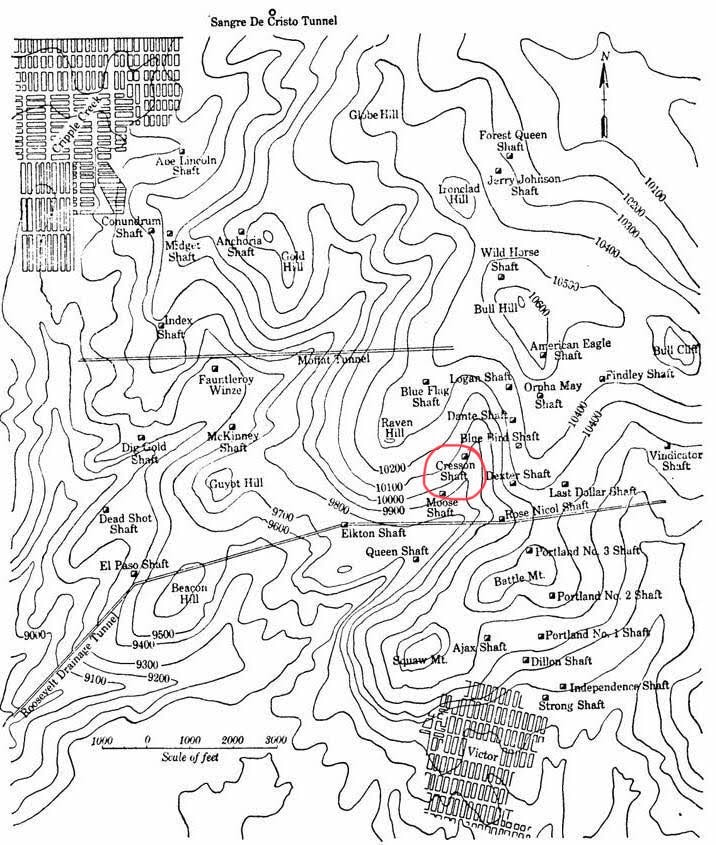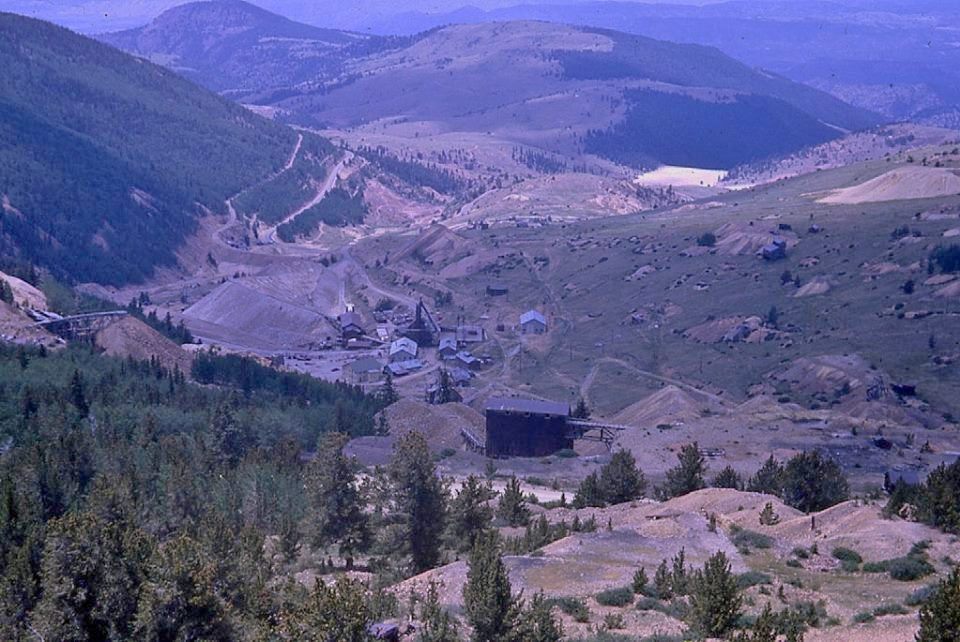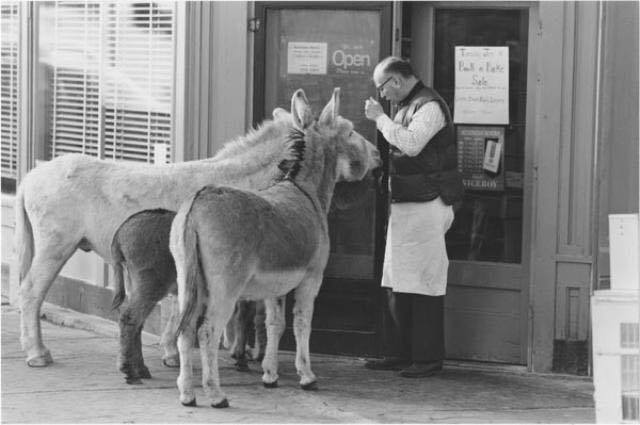A Day Spent in the Cresson Mine by Charles Norman Spray (AKA Jeep Hack). ©
I was raised in Victor, Colorado--commonly referred to as the City of Mines. Most all the major gold producing mines in the Cripple Creek Mining District were located on Battle Mountain above Victor. A few others were to be found outside that area but the big producers were on Battle Mountain. The mine I will talk about is the “Cresson Mine”. It was commonly referred to by locals as the “Duke”.
1911 Photo of Major Gold Producing Mines on Battle Mountain Visible from the City of Victor.
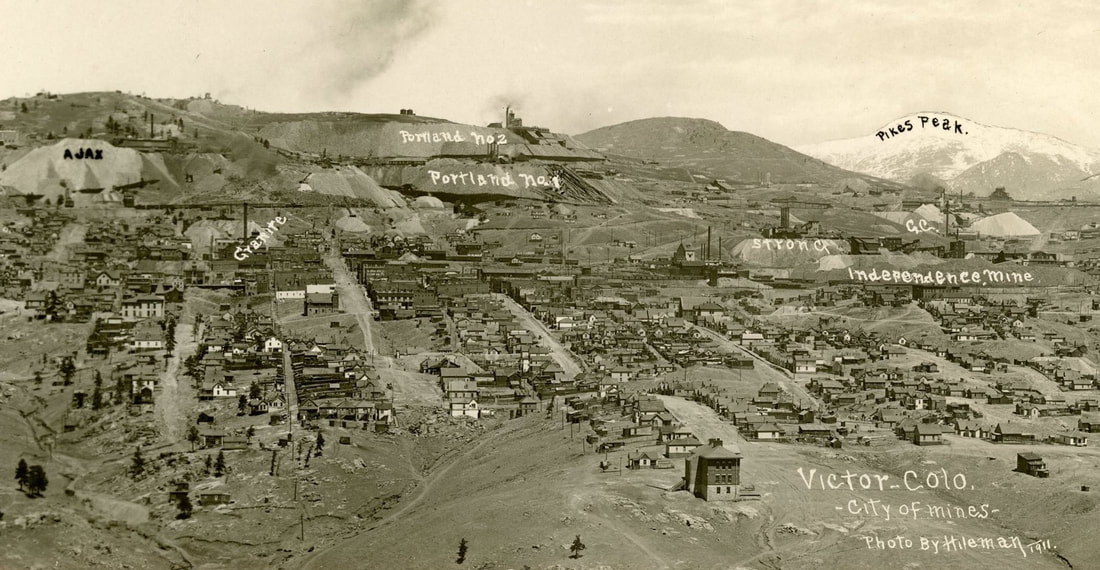
Viewed from the City of Victor in 1911, the gold mines on Battle Mountain were among the biggest producers in the historic Cripple Creek Mining District. Labeled from left to right are the Ajax, Granite (Gold Coin originally), Portlands 1 & 2, Strong, and Independence mines with the City of Victor in the foreground. Hileman photo from the Victor~Lowell Thomas Museum collection. The Cresson Mine, located on a portion of Battle Mountain not visible from the City of Victor, is shown in the next two photos.
The map below marks the historic Cresson Mine Shaft, also known as the "Duke",
located on a portion of Battle Mountain nearby (but not visible from) the City of Victor.
located on a portion of Battle Mountain nearby (but not visible from) the City of Victor.
My Uncle June Hack and his father-in-law Bill Ackelbien were leasing on the "Duke". While I don’t know all the particulars involved in leasing I know they were entitled to the proceeds on any ore they might find on their lease (ore being gold bearing rock). To cover the cost of their lease they probably paid a portion of the proceeds to the owners of the mine.
One day [in 1945] I was privileged to accompany June and Bill on an adventure (to me) down into the Cresson Mine. Mining in Victor is called Hard Rock Mining requiring blasting the earth with dynamite etc. There are no placer-gold surface deposits in the Cripple Creek Mining District. Mines were started by going to a promising area and starting to dig a hole down into the earth. This hole or “Shaft” continued down vertically, stopping at 100 foot levels to dig horizontal tunnels blasted off from the shaft going back into the mine in search of promising ore. Rails were put down in established tunnels allowing the blasted mine ore to be transported by tramcars from the blast site out to the main shaft and then taken above by the hoist bucket.
I can’t remember what “level” their lease was on but blasting on that level they came across a promising vein of gold and followed it with continued blasting. When the vein started to go up they followed it with blasting creating a vertical shaft over a period of time. At the onset when blasting, a large heavy steel plate was laid on the tram track to allow shoveling from a smooth surface. Woe was the individual that failed to lay the plate in place at day’s end prior to blasting. Now unable to shovel, it became a very difficult labor intense task. To collect the blasted rock (mostly by hand) required collecting it from between the rails, the rough surface, etc., then tossing it into the tramcar. Later as the vertical shaft grew upward a “Hopper” or large bin would be built at the bottom that collected the blasted ore. Opening the bin door allowed the ore to be dumped into a waiting tramcar sitting below--a real labor saving devise.
The shaft created by their following the vein upward required heavy cross beams wedged into the side of the cavity, then heavy planks were laid crosswise creating a platform to work off of. A heavy drill was hauled up and powered by water pressure piped from the surface, allowing the holes that would be necessary for the charges of dynamite to be placed. This was accomplished by a wooden rod with a hollow fixture on one end that held the stick of dynamite. The stick was then shoved up into the hole created by the drilling. Numerous holes would be drilled and several sticks of dynamite with cap and fuses intact would be shoved into each hole. I provided some amusement for Bill and June when I ducked and covered the top of my head with my hands when Bill rammed the first stick of dynamite into the first hole. I knew nothing so to speak about dynamite but from schoolroom class lectures annually given about dynamite caps, their danger and the resulting explosion when dropped or hit. I knew what would happen if a cap was scraped on the wall of that rocky hole.
I can’t remember what “level” their lease was on but blasting on that level they came across a promising vein of gold and followed it with continued blasting. When the vein started to go up they followed it with blasting creating a vertical shaft over a period of time. At the onset when blasting, a large heavy steel plate was laid on the tram track to allow shoveling from a smooth surface. Woe was the individual that failed to lay the plate in place at day’s end prior to blasting. Now unable to shovel, it became a very difficult labor intense task. To collect the blasted rock (mostly by hand) required collecting it from between the rails, the rough surface, etc., then tossing it into the tramcar. Later as the vertical shaft grew upward a “Hopper” or large bin would be built at the bottom that collected the blasted ore. Opening the bin door allowed the ore to be dumped into a waiting tramcar sitting below--a real labor saving devise.
The shaft created by their following the vein upward required heavy cross beams wedged into the side of the cavity, then heavy planks were laid crosswise creating a platform to work off of. A heavy drill was hauled up and powered by water pressure piped from the surface, allowing the holes that would be necessary for the charges of dynamite to be placed. This was accomplished by a wooden rod with a hollow fixture on one end that held the stick of dynamite. The stick was then shoved up into the hole created by the drilling. Numerous holes would be drilled and several sticks of dynamite with cap and fuses intact would be shoved into each hole. I provided some amusement for Bill and June when I ducked and covered the top of my head with my hands when Bill rammed the first stick of dynamite into the first hole. I knew nothing so to speak about dynamite but from schoolroom class lectures annually given about dynamite caps, their danger and the resulting explosion when dropped or hit. I knew what would happen if a cap was scraped on the wall of that rocky hole.
All I could see was all that dynamite with caps intact being rammed into each drilled hole. "Oh ye of little faith”. Bill Ackelbien had been handling dynamite all his life. To say he was a “Professional” would be a gross understatement. At that time I didn’t realize nor appreciate the fact that I was watching an artist skillfully applying his trade at ¾ of a mile underground. Anyhow, I somewhat earned my keep by providing a good laugh for my two “Partners” in the group. I however didn’t laugh!
A dozen or so holes had been drilled and filled with charges. It was a fascinating thing watching Bill cut the numerous hanging fuses to various lengths. He then took a short piece of fuse and at half inch intervals he cut little nicks out that when lit on the end produced a progression of traveling sparks. He then went from fuse to fuse igniting each from this creation.
Watching all of those slow burning fuses I again hit the panic button. Here we were standing on planks, 30 feet up in a blasted vertical shaft ¾ of a mile underground with eight or ten slow burning fuses with dynamite attached sputtering over our heads. My “Partners” were calmly lowering the drill, planks and other tools down to the main level below. To say I wasted no time in removing my panic stricken carcass from that hole would be another understatement. June later said he was amazed--he was unaware of my ability to fly!
Putting the plate down and placing all the other equipment safely to one side, we proceeded out to the station (the main shaft) that would take us top side. Unaware as to why we stood there for a while, I was spooked when the first charge went off followed by explosions one after another. While I had thought Bill had randomly hacked away when cutting all the fuses, I was once again astonished by this man’s ability and how he applied his trade. Bill had known the exact length to cut each fuse so the attached dynamite would be set off at spaced intervals. We stood there while Bill counted the explosions one by one and didn’t ring the bell to the hoist house until all the charges were accounted for. Bill graciously told “this would-be miner” that many inexperienced men returning to a shaft had been crushed when they returned to their shaft to start the day by mucking (shoveling) the ore dumped down by the previous day’s blasting and a hung charge would be set off and dropped on them by the noise their presence created below.
A dozen or so holes had been drilled and filled with charges. It was a fascinating thing watching Bill cut the numerous hanging fuses to various lengths. He then took a short piece of fuse and at half inch intervals he cut little nicks out that when lit on the end produced a progression of traveling sparks. He then went from fuse to fuse igniting each from this creation.
Watching all of those slow burning fuses I again hit the panic button. Here we were standing on planks, 30 feet up in a blasted vertical shaft ¾ of a mile underground with eight or ten slow burning fuses with dynamite attached sputtering over our heads. My “Partners” were calmly lowering the drill, planks and other tools down to the main level below. To say I wasted no time in removing my panic stricken carcass from that hole would be another understatement. June later said he was amazed--he was unaware of my ability to fly!
Putting the plate down and placing all the other equipment safely to one side, we proceeded out to the station (the main shaft) that would take us top side. Unaware as to why we stood there for a while, I was spooked when the first charge went off followed by explosions one after another. While I had thought Bill had randomly hacked away when cutting all the fuses, I was once again astonished by this man’s ability and how he applied his trade. Bill had known the exact length to cut each fuse so the attached dynamite would be set off at spaced intervals. We stood there while Bill counted the explosions one by one and didn’t ring the bell to the hoist house until all the charges were accounted for. Bill graciously told “this would-be miner” that many inexperienced men returning to a shaft had been crushed when they returned to their shaft to start the day by mucking (shoveling) the ore dumped down by the previous day’s blasting and a hung charge would be set off and dropped on them by the noise their presence created below.
|
Waiting for the lift at the station I was introduced to powder smoke. It came rolling out of our tunnel like a heavy fog and the sweet smell made me half sick. I learned a lot that day and gained a new found respect for Hard Rock Miners. If they ever found “High Grade Ore” they were among the fortunate few that ever enjoyed it. They earned it the hard way. June enjoyed enough off his share of the lease to buy him a grocery store in Cripple Creek that he and his wife Margaret ran for twenty five years.
|
My day in the Cresson Mine was an experience that a ten year old boy will always remember and treasure. June showed me around a little. I was amazed at the depth of the Duke’s main shaft and the miles and miles of tunnels running off the main shaft’s 100 foot levels. I was told the Duke’s main shaft was the deepest shaft in the district. I remember standing on top of the hoist bucket platform, hanging on the cable and looking back up in the shaft’s 3300 feet to just a pinpoint of light showing the outside world above. Down in the mine I realized I had never really known “Darkness” until I turned off the carbide lantern on my helmet. The darkness was so black you couldn’t see your hand in front of your face. The only sound to be heard was the drip, drip, drip of water leaking out of the darkness from the tons of earth above you. That dripping sound along with the dark produced an eerie feeling.
June also showed me the level in the Cresson where a room-sized cavern was found that was so rich in gold that the walls glistened with crystals like the inside of a giant geode. This discovery [in 1914] became known as “The Vug”. The ore was so rich that miners could stuff enough gold in their pockets to cover a month’s wages. This practice became known as “High Grading” and prompted the advent of “changing rooms” in the mine. Miners coming up out of the mine were required to go into the shedding room, remove all their mining clothes, walk past guards in the nude, then go into an adjoining room where they could dress in their street clothes.
June also showed me the level in the Cresson where a room-sized cavern was found that was so rich in gold that the walls glistened with crystals like the inside of a giant geode. This discovery [in 1914] became known as “The Vug”. The ore was so rich that miners could stuff enough gold in their pockets to cover a month’s wages. This practice became known as “High Grading” and prompted the advent of “changing rooms” in the mine. Miners coming up out of the mine were required to go into the shedding room, remove all their mining clothes, walk past guards in the nude, then go into an adjoining room where they could dress in their street clothes.
|
If any “Ole” Hard Rock miners read what I’ve written and take exception to the recollections of this boy’s memory, so be it. The boy never professed to be a miner. However the experience gained on that one day convinced him that he would pursue different ways of making a living above ground.
The years have rolled by. The Cresson [Underground] Mine, the "Duke", no longer exists. My mining companions, while no longer with us, will always be graciously remembered for their kindness in sharing one day in the “Duke” with a ten year old boy. |
Footnote: Bill and June mined their lease in the Cresson when the price of gold was $36 an ounce. As I recall, their ore on the day of my adventure was assaying at 1¼ ounces of gold to the ton of ore. A tramcar with side boards usually carried about a ton, so they were realizing about $50 per tramcar. I think they were rolling about 10 to 12 tramcars a day, so they were grossing about $500 a day. What they actually realized after covering the lease, I have no idea. Remember all these calculations were “I Think”. Don’t take any of my figures to the bank. Happy Trails, Jeep
---------------------
The Cresson Underground Mine remained idle after 1960 (except for a small operation in the early 1980's. High impact surface mining was initiated in 1994. [WesternMiningHistory.com]
---------------------
The Cresson Underground Mine remained idle after 1960 (except for a small operation in the early 1980's. High impact surface mining was initiated in 1994. [WesternMiningHistory.com]
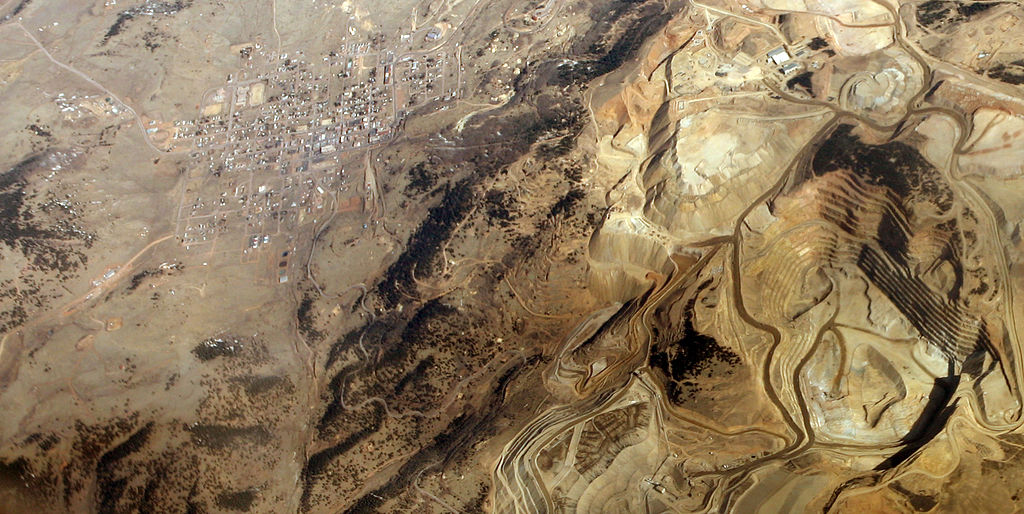
The scope & scale of modern surface / open pit mining in the District can be seen in this 2012 photo of mining operations near the
City of Cripple Creek. Photo from Searles in Wikipedia & https://www.flickr.com/photos/docsearls/6891003250. Surface mining operations have also continued to expand nearby the City Victor since 2012. Without seeing historic photos preserved from the 1890's & 1900's, it might be impossible for people today to visualize how underground mining first began in the District.
"A Day in the Cresson Mine" (submitted May 2020) by Charles Spray (also known as Jeep Hack). ©
Click the links below for companion stories by Charles Spray (AKA Jeep Hack):
Click the links below for companion stories by Charles Spray (AKA Jeep Hack):
- Recollections of My Life in Victor, Colorado During the Depression, WWII and After.
- Memories of Washington Elementary--My First School in Victor, Colorado.
- Adventures at the Beaver Valley Ranch while Growing Up in Nearby Victor, Colorado.
- Memorabilia from Cripple Creek & Victor High School Bands Directed by Ernest T. Sly.
- Memories of the Ina & Henry Cleveland Hack Family.
- The Lighter Side of a Visit to Hack's Victor Barbershop.
- Memories of Margaret & Henry C. "June" Hack, Jr.
- Firewood For Victor, Colorado.
- Sports in Victor & Memories of the 1949 Pikes Peak Junior High School Baseball Tournament.
- Winters in Victor, Colorado during the 1940's & early 50's.
- Tragedies When I Was Growing Up In Victor, Colorado in the 1940's & 1950's.
ABOUT THE AUTHOR
To discover why Charles Norman Spray was also known as Jeep Hack by his family and friends while growing up in Victor, click this highlighted link to his "Recollections of Life in Victor During the Great Depression, World War II and After". Charles (Chuck) Spray included this preface titled “ THE WHY OF IT ” with his more personal memoirs submitted in December 2019.
My daughter who was always telling me “Dad, write down some of the stories you are always telling me.” But I’d continue to procrastinate. Finally, to appease her I started writing. The more I continued to write, the more that came to light. Sometimes I’d worry about how to start and just how or what I wanted to say. Then I’d remember what that renowned writer of western tales Louis L’Amour once said. “Don’t wait for an idea. Don’t wait. Just Write”! He also was to have said another verbal truth, “You have to turn on the faucet before the water starts to flow”! “Just Write”.
Bear with me. I hope you have the time or inclination to put up with the ramblings and recollections of a world weary old man. Perhaps in the telling I’ve stirred up a few recollections you might have of your own life. Put them down. Don’t wait. Write them down for your grandchildren and their grandchildren to follow. The children of today need to know that some things weren’t always the way they are today--things that will never be in the history books nor be taught in the schools, things that made up your life. It’s important they know of the world you knew, what took place before I-Pods, texting, and the abuse of one of man’s greatest inventions, television.
Please forgive my grammar, spelling, punctuation and over-all abuse of the English language. The Cherokee people have no word in their language for goodbye, so I’ll just say “Happy Trails” until we meet again.
Chuck Spray
To discover why Charles Norman Spray was also known as Jeep Hack by his family and friends while growing up in Victor, click this highlighted link to his "Recollections of Life in Victor During the Great Depression, World War II and After". Charles (Chuck) Spray included this preface titled “ THE WHY OF IT ” with his more personal memoirs submitted in December 2019.
My daughter who was always telling me “Dad, write down some of the stories you are always telling me.” But I’d continue to procrastinate. Finally, to appease her I started writing. The more I continued to write, the more that came to light. Sometimes I’d worry about how to start and just how or what I wanted to say. Then I’d remember what that renowned writer of western tales Louis L’Amour once said. “Don’t wait for an idea. Don’t wait. Just Write”! He also was to have said another verbal truth, “You have to turn on the faucet before the water starts to flow”! “Just Write”.
Bear with me. I hope you have the time or inclination to put up with the ramblings and recollections of a world weary old man. Perhaps in the telling I’ve stirred up a few recollections you might have of your own life. Put them down. Don’t wait. Write them down for your grandchildren and their grandchildren to follow. The children of today need to know that some things weren’t always the way they are today--things that will never be in the history books nor be taught in the schools, things that made up your life. It’s important they know of the world you knew, what took place before I-Pods, texting, and the abuse of one of man’s greatest inventions, television.
Please forgive my grammar, spelling, punctuation and over-all abuse of the English language. The Cherokee people have no word in their language for goodbye, so I’ll just say “Happy Trails” until we meet again.
Chuck Spray
THE PAST MATTERS. PASS IT ALONG.
The Next Generation Will Only Inherit What We Choose to Save and Make Accessible.
Please Share Your Memories and Family Connections to Victor & the World's Greatest Gold Camp
By Contacting Victor Heritage Society, PO Box 424, Victor, CO 80860 or e-mail [email protected].
The Next Generation Will Only Inherit What We Choose to Save and Make Accessible.
Please Share Your Memories and Family Connections to Victor & the World's Greatest Gold Camp
By Contacting Victor Heritage Society, PO Box 424, Victor, CO 80860 or e-mail [email protected].
VictorHeritageSociety.com
Copyright © 2023 Victor Heritage Society. All Rights Reserved.
Copyright © 2023 Victor Heritage Society. All Rights Reserved.
